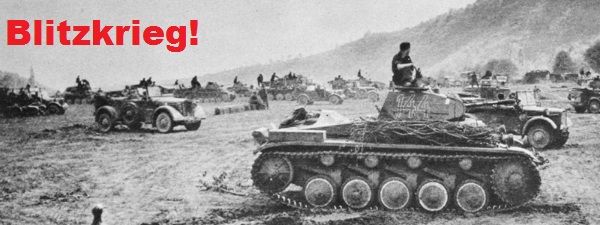 /> />
|
|


Adolph Hitler Reviewing German Troops On
The Road To Poland - 1 September 1939
From Today in U.S. Military History:
1 September 1939 – Hitler Invades Poland
"At 0445 hours German forces invade Poland without a declaration of war. The operation is code named Fall Weiss (Plan White). The Germans allot 52 divisions for the invasion (some 1.5 million men), including the 6 armored divisions and all their motorized units. Of the divisions left to defend against an Anglo-French front, only about 10 are regarded by the Germans as being fit for any kind of action. General Brauchitsch, the Commander-in-Chief of the German Army, is in command of the campaign. Bock leads Army Group North, consisting of the 4th Army (Kuchler) and 3rd Army (Kluge); Rundstedt leads Army Group South, consisting of 8th Army (Balskowitz), 10th Army (Reichenau) and 14th Army (List). Air support comes from two Air Fleets, commanded by Kesselring and Lohr, which have around 1,600 aircraft. Army Group South, advancing from Silesia, is to provide the main German attacks. The 8th Army on the left is to move toward Poznan, the principal thrust is to be delivered by 10th Army which is to advance in the center to the Vistula River between Warsaw and Sandomierz, while 14th Army on the right moves toward Krakow and the Carpathian flank. The 4th Army from East Prussia is to move south toward Warsaw and the line to the Bug River to the east; 3rd Army is to cross the Polish Corridor and join 4th Army in moving south. The Poles have 23 regular infantry divisions prepared with 7 more assembling, 1 weak armored division and an inadequate supply of artillery. They also have a considerable force of cavalry. The reserve units were only called up on August 30th and are not ready for combat. In the air, almost all the 500 Polish planes are obsolete and prove unable to blunt the impact of the German attack. During the day, the Luftwaffe launches air strikes on Warsaw, Lodz and Krakow. The Polish Commander in Chief, Marshal Rydz-Smigly, has deployed the stronger parts of his army in the northwestern half of the country, including large forces in the Poznan area and the Polish Corridor. He hopes to hold the Germans to only gradual gains. All along the front the superior training, equipment and strength of the Germans quickly brings them the advantage in the first battles. Many Polish units are overrun before their reinforcements from the reserve mobilization can arrive. At sea, as in the air, Polish technical inferiority leads to crushing early defeats. Three of the four Polish destroyers manage to leave for Britain before hostilities begin and later one submarine also escapes. On the first day the old pre-Dreadnought battleship, Schleswig-Holstein, bombards the Polish naval base at Westerplatte." |
|
|
|
|
|









 />
/> 
